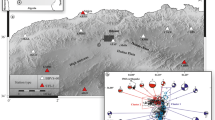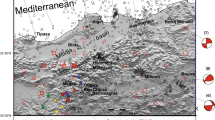Abstract
In this study, we present a new and effective method to determine the dynamic source parameters (i.e., stress drop and strength distribution). We first assume that the kinematic source parameters, i.e., the slip and rupture time distributions on the fault plane, are known from the previous source inversion studies. Then, using the seismic source representation theorem we determine the dynamic stress field on a fault plane from known kinematic parameters. Finally, we determine the strength of the fault defined as the peak stress just before the rupture. We have tested the validity of this method by using an illustrative two-dimensional analytical example. To assess the applicability of this method, we have applied it to study the 1979 Imperial Valley earthquake, and obtained consistent results with those ofMiyatake's (1992) andQuin's (1990). Compared with previous methods, this new method is simple, straightforward and accurate, and needs much less calculation. Therefore, it is expected to be useful in exploring the seismic source process.
Similar content being viewed by others
References
Aki, K., andRichards, P. G.,Quantitative Seismology: Theory and Methods (W. H. Freeman, San Francisco, 1980).
Archuleta, R. J. (1984),A Faulting Model for the 1979 Imperial Valley Earthquake, J. Geophys. Res.89, 4559–4585.
Das, S., andAki, K. (1977),A Numerical Study of Two-dimensional Spontaneous Rupture Propagation, Geophys. J.R. Astr. Soc.50, 643–668.
Hartzell, S., andHeaton, T. (1983),Inversion of Strong Ground Motion and Teleseismic Wave Form Data for the Fault Rupture History of the 1979 Imperial Valley, California Earthquake, Bull. Seismol. Soc. Am.73, 1553–1583.
Kasahara, K.,Earthquake Mechanics (Cambridge University Press, New York 1981).
Knopoff, L. (1958),Energy Release in Earthquake, Geophys. J. MNRAS1, 44–52.
Miyatake, T. (1992),Reconstruction of Dynamic Rupture Process of an Earthquake, Geophys. Res. Lett.19, 349–352.
Olson, A. H., andApsel, R. (1982),Finite Faults and Inverse Theory with Applications to the 1979 Imperial Valley Earthquake, Bull. Seismol. Soc. Am.72, 1969–2002.
Quin, H. (1990),Dynamic Stress Drop and Rupture Dynamics of the October 15, 1979 Imperial Valley, California, Earthquake, Tectonophysics175, 83–117.
Author information
Authors and Affiliations
Rights and permissions
About this article
Cite this article
Chen, X., Aki, K. An effective approach to determine the dynamic source parameters. PAGEOPH 146, 689–696 (1996). https://doi.org/10.1007/BF00874740
Received:
Revised:
Accepted:
Issue Date:
DOI: https://doi.org/10.1007/BF00874740




